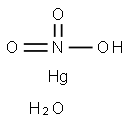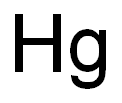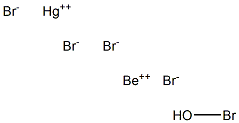MERCURIC BROMIDE
Synonym(s):Mercuric bromide;Mercury(II) bromide
- CAS NO.:7789-47-1
- Empirical Formula: Br2Hg
- Molecular Weight: 360.4
- MDL number: MFCD00011040
- EINECS: 232-169-3
- SAFETY DATA SHEET (SDS)
- Update Date: 2025-01-27 09:38:02

What is MERCURIC BROMIDE?
Description
Mercuric Bromide is a crystalline solid. Molecular weight= 360.41;Boiling point=322℃; Freezing/Melting point=236℃. Hazard Identification (based on NFPA-704 M Rating System): Health 3, Flammability 0, Reactivity 0. Slightly soluble in water.
Chemical properties
white crystalline powder
Chemical properties
Mercuric Bromide is a crystalline solid
The Uses of MERCURIC BROMIDE
Medicine.
The Uses of MERCURIC BROMIDE
Mercury(II) bromide is used as a reagent in the Koenigs-Knorr reaction, which forms glycoside linkages on carbohydrates. It is also used to test for the presence of arsenic, as recommended by the Pharmacopoeia.
Definition
ChEBI: Mercury dibromide is a mercury coordination entity composed of mercury and bromine with the formula HgBr2.
General Description
White rhombic crystals. Sensitive to light. Slightly soluble in water and denser than water. Severely toxic by inhalation and ingestion.
Air & Water Reactions
Slightly soluble in water.
Reactivity Profile
MERCURIC BROMIDE is incompatible with acetylene, ammonia, chlorine dioxide, azides, calcium (amalgam formation), sodium carbide, lithium, rubidium, copper . Reacts with sodium azide to give mercury(II) azide, which is sensitive to shock, friction, and heat. Mixing with hydrazine salts in basic solution produced a heat or shock sensitive yellow precipitate [Annalen, 1899, 305, 191]. Reacts violently with chlorine trifluoride *with ignition often occurring.
Hazard
Toxic by inhalation, ingestion, and skin absorption; strong irritant.
Health Hazard
TOXIC; inhalation, ingestion or skin contact with material may cause severe injury or death. Contact with molten substance may cause severe burns to skin and eyes. Avoid any skin contact. Effects of contact or inhalation may be delayed. Fire may produce irritating, corrosive and/or toxic gases. Runoff from fire control or dilution water may be corrosive and/or toxic and cause pollution.
Fire Hazard
Non-combustible, substance itself does not burn but may decompose upon heating to produce corrosive and/or toxic fumes. Some are oxidizers and may ignite combustibles (wood, paper, oil, clothing, etc.). Contact with metals may evolve flammable hydrogen gas. Containers may explode when heated.
Safety Profile
A poison by ingestion, skin contact, and intraperitoneal routes. Vigorous reaction with indium at 35OC. Incompatible with sodmm and potassium. When heated to decomposition it emits very toxic fumes of Brand Hg. See also MERCURY COMPOUNDS and BROMIDES.
Potential Exposure
This compound has applications in medicine.
First aid
If this chemical gets into the eyes, remove any contact lenses at once and irrigate immediately for at least 15 min, occasionally lifting upper and lower lids. Seek medical attention immediately. If this chemical contacts the skin, remove contaminated clothing and wash immediately with soap and water. Seek medical attention immediately. If this chemical has been inhaled, remove from exposure, begin rescue breathing (using universal precautions, including resuscitation mask) if breathing has stopped and CPR if heart action has stopped. Transfer promptly to a medical Mercuric bromide 1683 facility. When this chemical has been swallowed, get medical attention. Give large quantities of water and induce vomiting. Do not make an unconscious person vomit. Medical observation is recommended for 2448 h after breathing overexposure, as pulmonary edema may be delayed. As first aid for pulmonary edema, a doctor or authorized paramedic may consider administering a corticosteroid spray. Antidotes and special procedures for medical personnel: The drug NAP (n-acetyl penicillamine) has been used to treat mercury poisoning, with mixed success. Note to physician: For severe poisoning BAL [British AntiLewisite, dimercaprol, dithiopropanol (C3H8OS2)] has been used to treat toxic symptoms of certain heavy metals poisoning including mercury. Although BAL is reported to have a large margin of safety, caution must be exercised, because toxic effects may be caused by excessive dosage. Most can be prevented by premedication with 1-ephedrine sulfate (CAS: 134-72-5).
Storage
Color Code—Blue: Health Hazard/Poison: Store in a secure poison location. Prior to working with this chemical you should be trained on its proper handling and 1684 Mercuric bromide storage. Store in tightly closed containers in a cool, wellventilated area away from light, heat, and acids. Mercuric bromide must be stored to avoid contact with sodium and potassium, since violent reactions occur.
Shipping
UN1634 Mercuric bromides, Hazard Class: 6.1; Labels: 6.1-Poisonous materials
Purification Methods
Crystallise it from hot saturated ethanolic solution, dry and keep it at 100o for several hours under a vacuum, then sublime it. [Garrett J Am Chem Soc 61 2744 1939.] Its solubility in H2O is 0.6% at 20o, and 22% at 100o; in EtOH it is 30% at 25o; and in MeOH it is 69.6% at 25o. [Wagenknecht & Juza Handbook of Preparative Inorganic Chemistry (Ed. Brauer) Academic Press Vol II p 1109 1965.] POISONOUS.
Incompatibilities
Violent reaction with active metals; potassium, sodium. Store away from heat and light
Properties of MERCURIC BROMIDE
| Melting point: | 236 °C(lit.) |
| Boiling point: | 322 °C(lit.) |
| Density | 6.1 |
| vapor pressure | 1 mm Hg ( 136.5 °C) |
| Flash point: | 322-325°C subl. |
| storage temp. | Poison room |
| solubility | Soluble in hot alcohol, methanol, HCl, HBr |
| form | beads |
| Specific Gravity | 6.109 |
| color | White |
| Water Solubility | g/100g solution H2O: 0.3 (0°C), 0.611±0.002 (25°C), 4.7 (100°C) [KRU93]; very soluble hot alcohol, methanol, HCl, HBr; slightly soluble chloroform [MER06] |
| Sensitive | Light Sensitive |
| Merck | 14,5875 |
| Solubility Product Constant (Ksp) | pKsp: 19.21 |
| Stability: | Stable, but may be light sensitive. Incompatible with potassium and sodium. |
| CAS DataBase Reference | 7789-47-1(CAS DataBase Reference) |
| EPA Substance Registry System | Mercury bromide (HgBr2) (7789-47-1) |
Safety information for MERCURIC BROMIDE
| Signal word | Danger |
| Pictogram(s) |
 Skull and Crossbones Acute Toxicity GHS06  Health Hazard GHS08  Environment GHS09 |
| GHS Hazard Statements |
H373:Specific target organ toxicity, repeated exposure H410:Hazardous to the aquatic environment, long-term hazard |
| Precautionary Statement Codes |
P262:Do not get in eyes, on skin, or on clothing. P264:Wash hands thoroughly after handling. P264:Wash skin thouroughly after handling. P273:Avoid release to the environment. P280:Wear protective gloves/protective clothing/eye protection/face protection. |
Computed Descriptors for MERCURIC BROMIDE
MERCURIC BROMIDE manufacturer
New Products
4,4-Difluoropiperidine hydrochloride tert-butyl 9-methoxy-3-azaspiro[5.5]undecane-3-carboxylate Indole Methyl Resin N-Isopropylurea N,N-Dicyclohexylcarbodiimide(DCC) MELDRUMS ACID 5-METHYLISOXAZOLE-4-CARBOXYLIC ACID Magnessium Bis glycinate Zinc ascorbate 1-bromo-2-butyne 2-acetamidophenol 9(10H)-anthracenone Erythrosin B, 4-Piperidinopiperidine 2-((4-morpholinophenylamino) (methylthio) methylene) malononitrile 2,4-dihydroxybenzaldehyde 3-(4-morpholinophenylamino)-5-amino-1H-pyrazole-4-carbonitrile Methyl 2-methylquinoline-6-carboxylate 2,6-dichloro-4-nitropyridine 4-Bromo-2-chlorobenzonitrile 2-(benzylamino)acetic acid hydrochloride 4-(tert-Butoxycarbonylamino)but- 2-ynoic acid 3,4-dihydro-2H-benzo[b][1,4]dioxepine 1-Phenyl-1-cycloprppanecarboxylicacidRelated products of tetrahydrofuran








You may like
-
 Mercury(II) bromide, For ACS analysis CAS 7789-47-1View Details
Mercury(II) bromide, For ACS analysis CAS 7789-47-1View Details
7789-47-1 -
 Mercury(II) bromide CAS 7789-47-1View Details
Mercury(II) bromide CAS 7789-47-1View Details
7789-47-1 -
 Mercuric Bromide extrapure AR CAS 7789-47-1View Details
Mercuric Bromide extrapure AR CAS 7789-47-1View Details
7789-47-1 -
 Mercury(II) bromide, GR CAS 7789-47-1View Details
Mercury(II) bromide, GR CAS 7789-47-1View Details
7789-47-1 -
 MERCURIC BROMIDE AR/ACS CAS 7789-47-1View Details
MERCURIC BROMIDE AR/ACS CAS 7789-47-1View Details
7789-47-1 -
 Mercury(II) bromide CAS 7789-47-1View Details
Mercury(II) bromide CAS 7789-47-1View Details
7789-47-1 -
 Mercuric bromide 99% AR/ACS CAS 7789-47-1View Details
Mercuric bromide 99% AR/ACS CAS 7789-47-1View Details
7789-47-1 -
 20677-73-0 (2,2-diethoxyethyl)methylamine 98%View Details
20677-73-0 (2,2-diethoxyethyl)methylamine 98%View Details
20677-73-0
